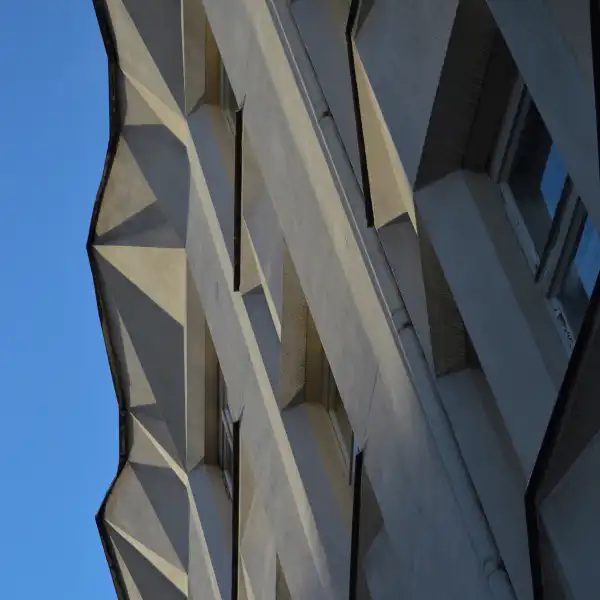Glass Route
Sheer beauty...
Façades that reflect the beauty of Prague, just like the surface of the Vltava River. Czech glassmaking has always been renowned, and it plays a significant role in Prague’s architecture as well. This route will guide you through buildings where glass takes center stage, whether as a detail complementing historical structures or as the main theme of the entire building. Come and explore Prague through the shimmering reflections of glass panels.

Duration:
30 minut
Number of stops:
6 + 6
Lenght:
2,6 km
MHD start:
Hellichova
MHD end:
Palackého náměstí
Museum Kampa
Architect: Josef Schulz a Josef Zítek
Year of completion: 1867
The gleaming white Museum Kampa on the island of the same name is complemented by sculptures of yellow penguins by the Cracking Art Group and a trio of babies by David Černý. The history of the Sova’s Mills, where the museum is located, dates back to the 10th century, but they acquired their name in 1478 when they were acquired by Václav Sova from Liboslav. Over the centuries, the mills have undergone several changes in appearance and function. The most significant events were the Gothic Revival renovation in the late 19th century by Josef Schulz, which added the typical gabled facades, and unfortunately, a subsequent fire that permanently ended mill operations.
The complex acquired its current form in 2000-2001 when it was reconstructed for the purposes of the Jan and Meda Mládek Foundation Gallery. The historical building was complemented by a glass bridge designed by Václav Cigler and a distinctive glass prism by Marian Karel. The entire reconstruction was overseen by Viennese architect Helena Bukovanská.
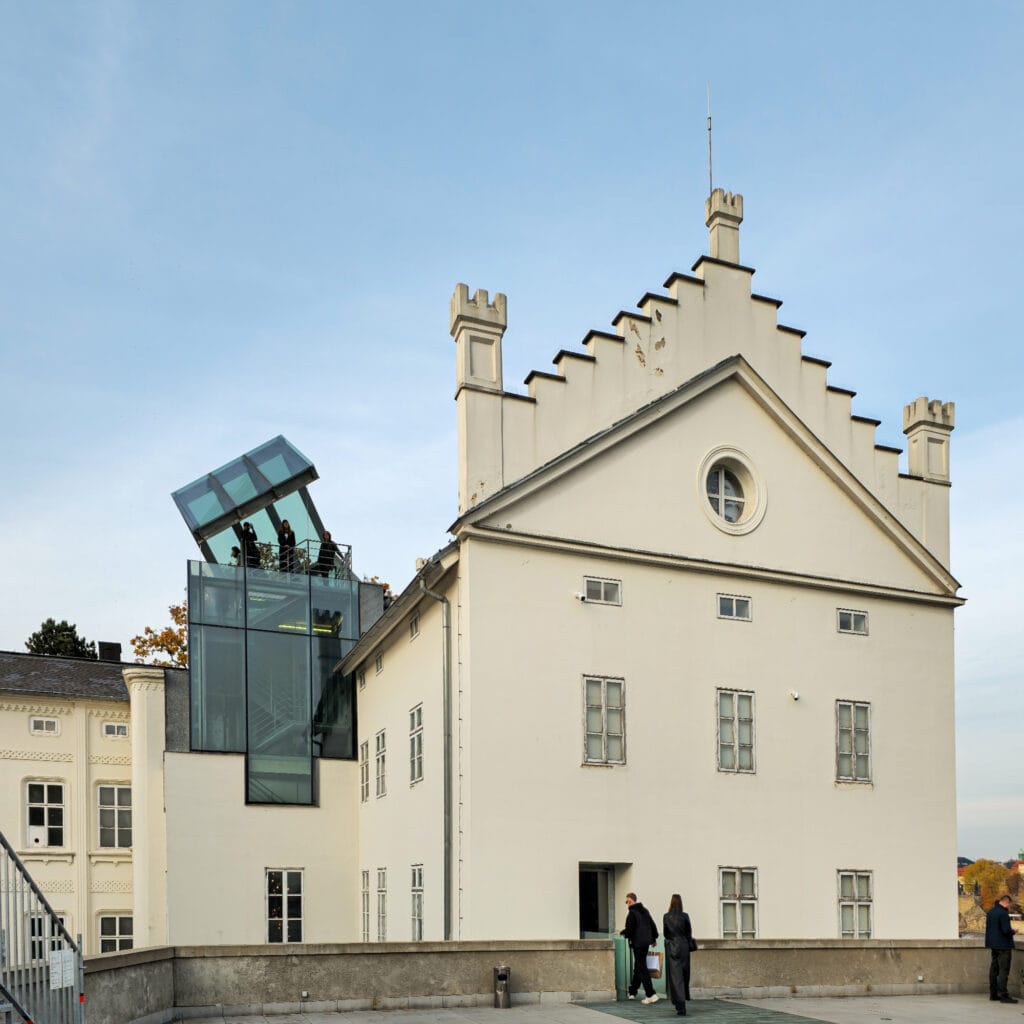
New Stage of the National Theatre
Architect: Karel Prager
Year of completion: 1983
The building of the New Stage of the National Theatre welcomed its first audience on the 100th anniversary of the reopening of the historic theatre building. It was constructed in response to the pan-European trend of alternative forms of theatre performances and also served as the new home of the world’s first multimedia theatre, Laterna Magika. Numerous architects were involved in the complex project, starting with Bohuslav Fuchs and ending with Karel Prager. Prager joined the project when the building was already under construction, but his intervention left a mark in history. In collaboration with the renowned duo Libenský and Brychtová, he adorned the stage with a glass envelope composed of 4,306 blown hollow screens, each weighing around 40 kilograms. Thus, Prager succeeded in creating the largest glass architectural sculpture ever realized.

Drn
Architect: Stanislav Fiala
Year of completion: 2017
The multifunctional building called Drn has been standing on the corner of Národní třída and Mikulandská Street since 2017. It fills the gap that had been used as a parking lot for many decades. The glassy curved structure harmonizes with the baroque Schönkirch Palace, creating a fascinating interplay between the old and the new. After passing through the modern building, you find yourself in a publicly accessible charming courtyard of the baroque neighbor.
The architect played with details in the construction, and besides the large glass surfaces and the backdrop of green balconies, you can observe wire structures referencing natural motifs. The interior is dominated by concrete creatively complemented by original recycled elements such as bricks, roof tiles, and wooden beams.

House of Children’s Book
Architect: Stanislav Franc, Luděk Hanf
Year of completion: 1970
The corner building on Národní třída, still known as the “Dům Dětské knihy” (House of Children’s Books), stands on the site of the former Brauner House. It was home to the famous Union Café from 1820, where many artists and writers such as Alois Jirásek, Mikoláš Aleš, and architects Josef Gočár and Pavel Janák used to gather. However, in 1949, the house was demolished, and between 1964 and 1970, it was replaced by a very modern eight-story building with a valuable suspended glass façade.
In the 1990s, the House of Children’s Books underwent a radical reconstruction during which a ninth floor was added, and both the façade and interiors were modified. Unfortunately, this forever changed the character and architectural qualities of the original structure. The building had been used by Albatros Publishing for many years, but after a recent major renovation and change of ownership, most of the spaces have been taken over by the co-working company Spaces.

The Dancing House
Architect: Frank O. Gehry, Vlado Milunič
Year of completion: 1996
The Dancing House replaced a corner tenement building that was destroyed during the bombings in February 1945. The vacant lot remained empty until the 1990s when architect Vlado Milunič and President Václav Havel, who lived in the neighboring house, started discussing its future. Milunič later invited American architect Frank O. Gehry to join the project at the request of the investor, resulting in a building often nicknamed Ginger and Fred. The inspiration from the famous interwar dance couple is evident in the design of the building.
The solid, heavy mass of the corner tower, expanding upwards, represents the male figure. In contrast, the female dancer is depicted in the glass part of the building, resembling billowing skirts. The glass envelope, concealing the reinforced concrete structure, gracefully descends to the ground on unevenly shaped columns. The entire structure is completed by Fred’s steel crown, which houses a publicly accessible rooftop bar.

Vaults of the embankment
Architect: Studio Brainwork, Petr Janda
Year of completion: 2019
The glazed vaults on the Novoměstská náplavka (New Town Embankment) are a great example of modern Prague architecture that complements the old with the new. In this case, they are known as “čapadla” or passages through the riverside wall, originally used to catch boats. These formerly purely utilitarian spaces have undergone a complete reconstruction and now house restaurants, cafes, and cultural venues. The original vault doors have been replaced by gigantic glazed windows weighing up to 2.5 tons. The principle is based on maximizing the connection between the exterior and interior, achieved through these enormous pivoting lenses.
The revitalization of Prague’s embankments on the Rašínovo and Hořejší Embankments is one of the largest urban investments in public spaces in years. Thanks to this initiative, the areas along the river have become even more open to people, fully realizing the potential of the embankments.

Zastávky mimo trasu

The Glass Palace
Architect: Richard Podzemný
Year of completion: 1937
The Glass Palace, popularly known as “Skleňák,” is a corner residential building commissioned by the Zemská bank. It was designed by architect Richard F. Podzemný, who is also the author of the well-known Podolí swimming stadium. This monumental residential structure has seven floors, and its facade is adorned with balconies, loggias, and winter gardens. It acquired its nickname due to these large exposed glass surfaces, which were quite rare at the time of its construction. The rest of the facade is covered with white ceramic tiles, and the window frames are also dressed in the typical functionalist white color.
The house was exceptionally well-equipped for its time. It featured underfloor heating, an artistically decorated entrance hall, an extensive basement with parking spaces, a tennis court in the inner courtyard, and a rooftop terrace where residents could enjoy sunbathing on summer days.

The Czech post main building
Architect: Antonín Brandner
Year of completion: 1874
Originally, the site of the current imposing late Neoclassical palace was occupied by a botanical garden owned by Angela of Florence, who cultivated medicinal herbs for Emperor Charles IV himself. In 1744, the Celestine order settled here, and their building with a chapel was designed by Kilián Ignác Dientzenhofer. The monastery was dissolved by Joseph II and demolished in 1871 to make way for the planned new post office. The wings of the building, designed by architect Antonín Brandner, have a floor plan in the shape of the number eight and enclose a covered courtyard and an inner courtyard. The highlight of the hall is the mural painting by Karel V. Mašek in the Neo-Renaissance style, featuring floral motifs and allegorical figures representing postal services and transportation. The glass roof of the hall was added in 1898, creating a well-lit and architecturally interesting partitioned hall.

The department store Bílá labuť
Architect: Josef Kittrich, Josef Hrubý
Year of completion: 1939
The department store Bílá labuť (White Swan) got its name from the baroque house that stood in its place. It was opened shortly before the outbreak of World War II and became the largest and most modern department store in Central Europe. It provided a luxurious shopping experience with a range of unprecedented technologies for its time: escalators, ceiling heating, and so-called pneumatic cash registers connecting various departments. The main facade facing Na Poříčí Street is composed of 180 glass panels, joined together to form one giant window measuring 30 × 18 meters. An unmistakable feature of the building is an eight-meter neon swan, which has been circling above the department store since its opening. Although Bílá labuť has undergone several reconstructions and experienced various political regimes, its original purpose has remained intact, and extensive restoration is also planned.
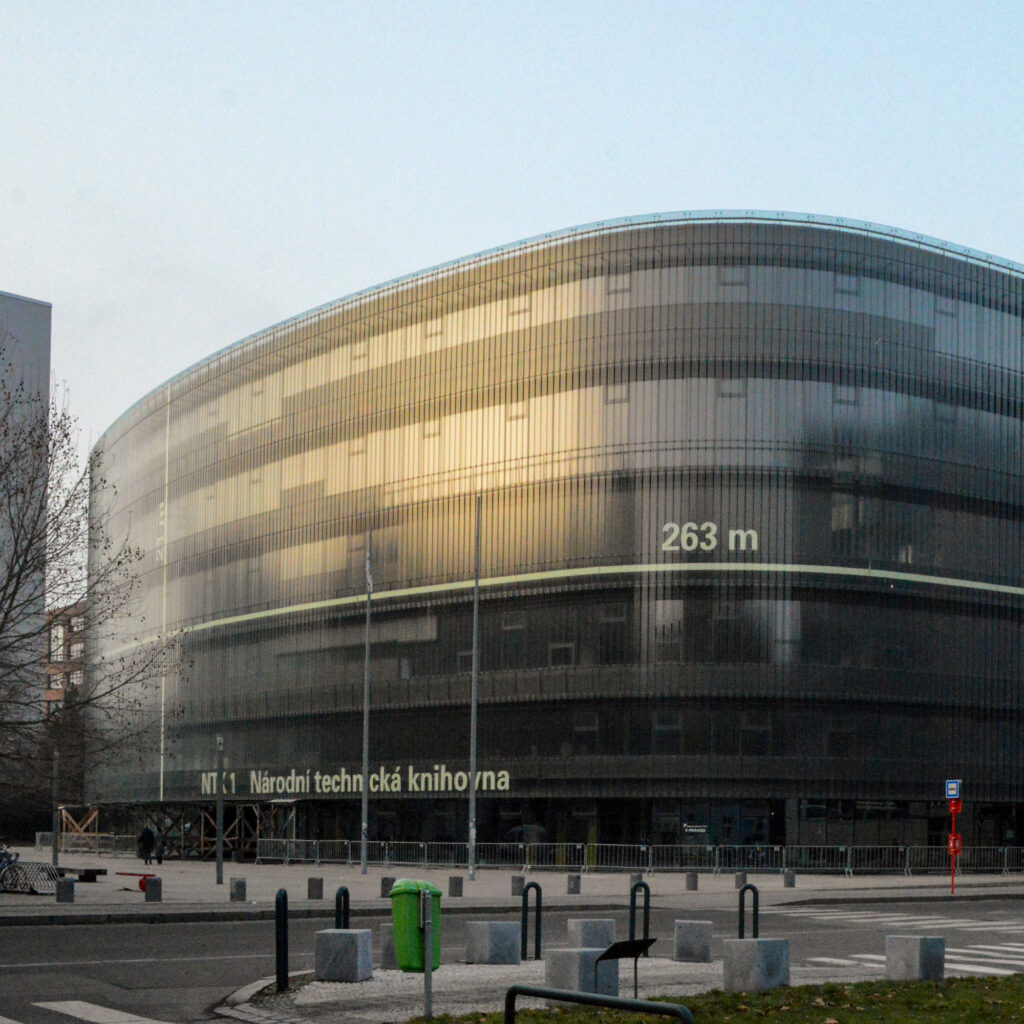
National Technical Library
Architect: Projektil architekti
Year of completion: 2009
The project of the building that no one calls anything other than NTK (National Technical Library) was created as part of an anonymous architectural competition in 2000. The winning design came from a young architectural studio, featuring a floor plan in the shape of a rounded square and a glass envelope. The double facade utilizes a total of 4,500 triangular glass panels, giving it a sense of infinity. The ground floor is designed as a public space with four entrances, allowing for seamless movement throughout the building without a main entrance. The actual library, with its concrete interior atrium, starts from the second floor. The overall impression of the interior is significantly influenced by the graphics of Petr Babák, who approached the building as a textbook and complemented it with various technical information, including a rainbow floor indicating load capacity. Another significant layer is the satirical drawings of Dan Perjovschi, in which one can always find new meanings.

Pavilon Expo 58
Architect: František Cubr, Josef Hrubý, Zdeněk Pokorný
Year of completion: 1958, 1959 přemístěna z Bruselu na Letnou
The Czechoslovak Pavilion at the first post-war Expo in 1958 was a true sensation. The Brussels pavilion with its restaurant shone to such an extent that it won the main prize, the Golden Star, as well as 56 other awards. The success was mainly attributed to the famous trio of young architects whose project stood out for its perfect purity of form and innovative technological and structural solutions. The semi-circular structure of the restaurant with its glass facade seemed to erase the differences between what was inside and what was outside with its transparency. The revolutionary Laterna Magika, the world’s first multimedia theater, located in a small cultural hall within its own pavilion, also sparked immense interest among Expo visitors. Due to its great success, the architectural masterpiece was relocated to Prague. The larger part stood at the Exhibition Grounds, but it burned down in 1991. On the other hand, the graceful two-story glassed restaurant facility still serves as a gallery overlooking Prague to this day.

Golden Angel
Architect: Jean Nouvel
Year of completion: 2000
The urban building Zlatý Anděl (Golden Angel) got its name from its predecessor, the neoclassical U Zlatého anděla (At the Golden Angel) house from the 19th century, which had a large fresco of a flying angel in the tympanum above the entrance. You can still find this fresco above the staircase in the administrative building designed for the Dutch ING bank by the famous French architect Jean Nouvel. The most prominent part is the slightly protruding glass tower that gradually descends towards Plzeňská Street, creating a terraced effect and matching the height of the neighboring synagogue building. The fully glazed facade ensures maximum daylight penetration while also accommodating a semi-transparent figure of an angel borrowed from Wim Wenders’ film “Wings of Desire.”

Garden route

Feminist route
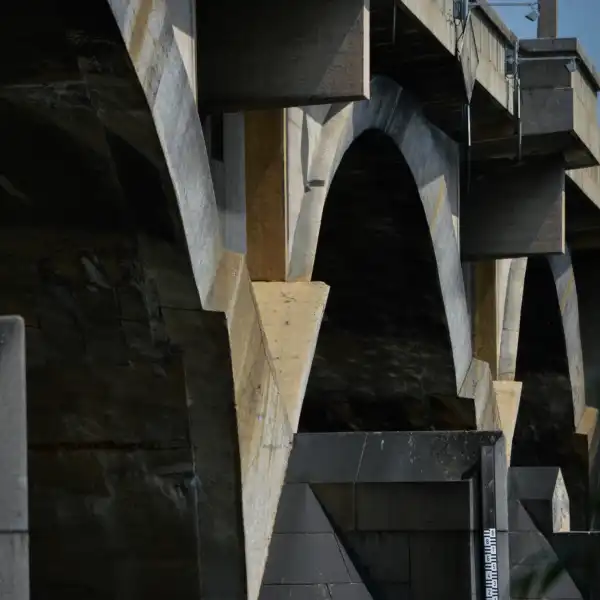
Bridge Route
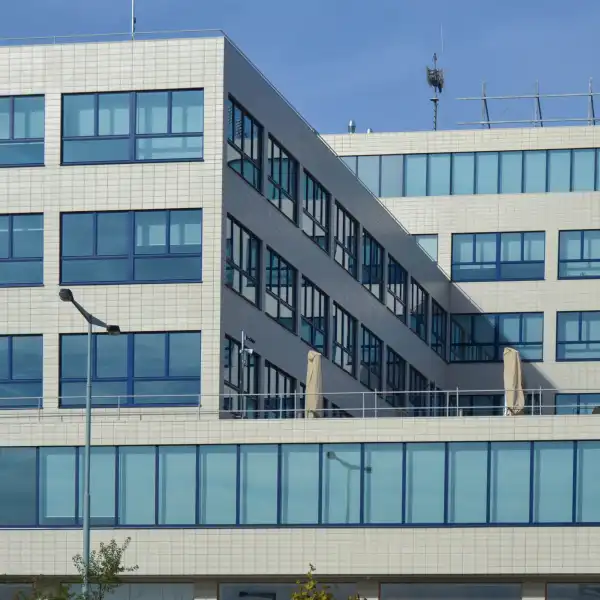
Functionalist Route

Passage Route
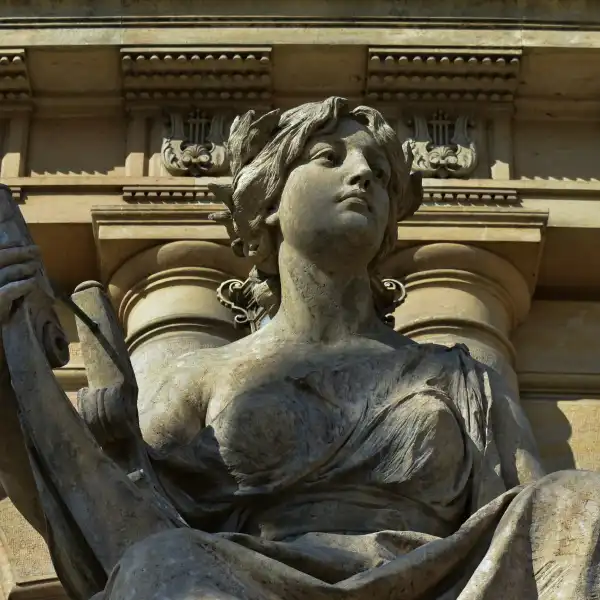
Music Route

Church Route (1930s)

Prager’s Route
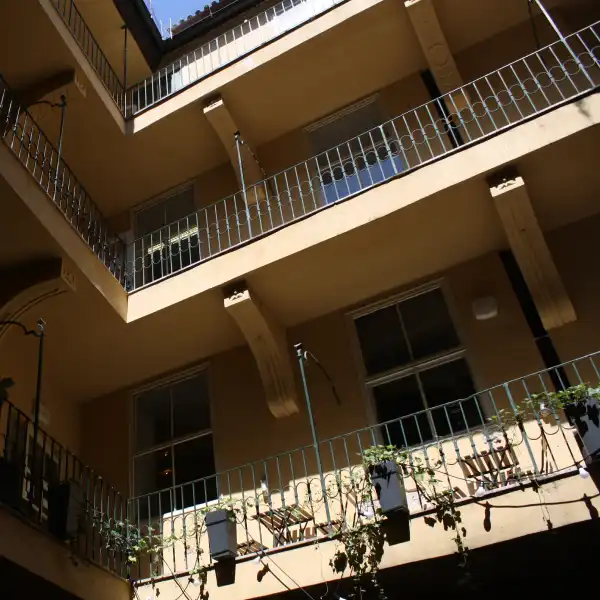
Inner Courtyard Route

Empty Route

Literary Route

Brutalist route
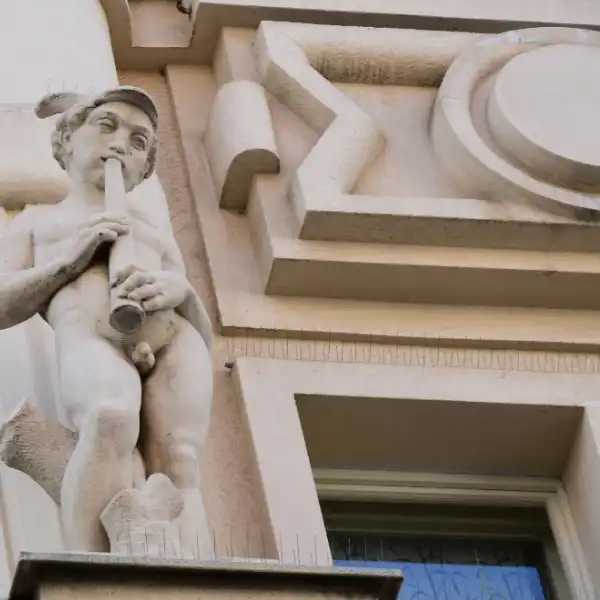
Rondocubist route
